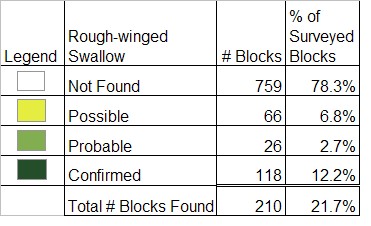Breeding Bird Atlases (BBA)
Find a Bird - BBA1
Breeding Bird Atlas 1 Species Accounts
Northern Rough-winged Swallow
Stelgidopteryx serripennis
Egg Dates
May 7 to June 12
Number of Broods
one; may re-lay if first attempt fails.

The Northern Rough-winged Swallow was unrecorded anywhere in New England prior to 1850. The species appears to have undergone a significant range expansion through most of the historical period, apparently first entering Massachusetts via the Hudson and Hoosic river valleys in the late 1880s. The first Massachusetts nesting record was in 1890. By the 1940s, this swallow was well established throughout most of the state. During the Atlas period, it was found to have a sparse, yet generalized distribution in Massachusetts with no evident pattern. Since 1987, nesting has occurred sporadically on Nantucket (Perkins, Andrews).
One of the most interesting things about Northern Rough-winged Swallows is their adaptability to a wide variety of nesting situations, many of them artificial and frequently in close proximity to humans and often near water. They are also unique among swallow species in possessing a ragged “saw edge” of tiny hooklets along the outer web of the ninth primary. They are rather quiet, even phlegmatic, in disposition compared with other swallows. They typically spend many hours quietly perched on small branches or wires and are most active and noisiest in the hour or so after dawn and before dusk. When a nest is approached, both sexes often wheel about close to the intruder. Their flight is noticeably powerful and less erratic than that of other swallows, and their call is a rasping brrt or brzzt.
Northern Rough-winged Swallows return to Massachusetts in mid-April; however, they do not start nest building until May. Males sometimes arrive at a site first, although sometimes pairs appear to arrive already mated. They nest solitarily, though loose colonies of 3 to 20 pairs may establish themselves where conditions are favorable. One of the largest breeding groups in the state is at the West Hill Dam in Uxbridge, where at least 15 pairs have nested in some seasons (TC). There is little evidence of territorial behavior in this swallow. Nest building has been observed from May 10 to May 26 (Meservey). Females do virtually all of the actual nest construction, although the male generally accompanies his mate back to the nest hole, usually stopping short of entering but settling on a nearby perch.
Some females fashion a well-defined mud bowl, others a very disorganized, indifferently built saucer. Pine needles, bits of leaves, grasses, and rootlets are commonly added. For nesting, Northern Rough-winged Swallows utilize refurbished burrows and ready-made cavities, especially pipes. Occasionally, the birds excavate burrows, using their feet to push soil backward out of the tunnel. Nests are usually situated from 9 inches to 6 feet back in the tunnel. When refurbishing former burrows, they thoroughly remove any previous nesting material. Dug holes are larger and more elliptical than Bank Swallow holes and may be 2 feet or more above the ground. Flooding of both natural and artificial sites by torrential downpours, stream freshets, and moon tides is the primary threat to nest sites.
Clutches of four to eight (usually six or seven) glossy white, unmarked eggs are produced. During egg laying, the female spends the night on the nest. The incubation period is 16 days, and only the female performs this task. The male remains nearby on an accustomed perch. If nesting is interrupted, second nesting attempts are common. The altricial young are fed by both parents and fledge at 19 to 21 days of age. In Massachusetts, nestlings have been recorded from June 9 to June 30 (Meservey). Food items brought for the young include small, soft-bodied flying insects, especially flies. As they mature, the young leave the nest and move about in the tunnel. In some nests, adults scrupulously remove fecal sacs right up until the last chicks fledge while in others the tunnels are strewn with fecal sacs and debris.
Fledglings are well developed and resemble adults. After fledging, neither the young nor the adults return to the burrow, and they depart almost immediately for the south, seldom being reported after mid-August. Families with fledged young have been reported in the state from June 22 to July 25, and brood size for 9 of these family groups ranged from 3 to 9 (Meservey). They winter from southern Florida, southern Louisiana, and northern Mexico south to Panama.
Map Legend and Data Summary
Atlas 1 data collected from 1975-1979


Note: uncommon and local throughout most of the state; prefers drain pipes, crevices, and sandbanks for nesting
Bradford G. Blodget



